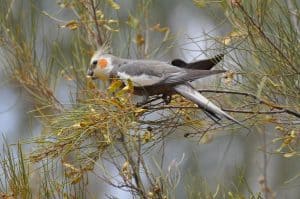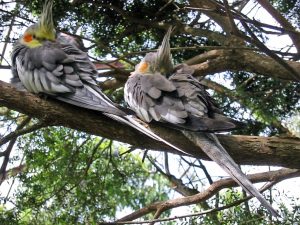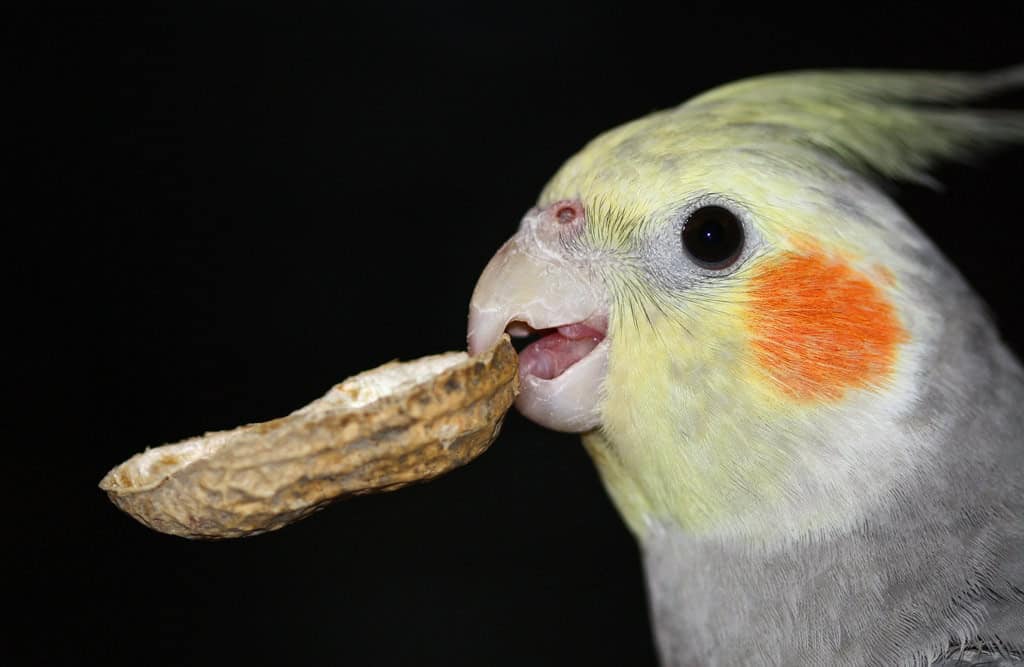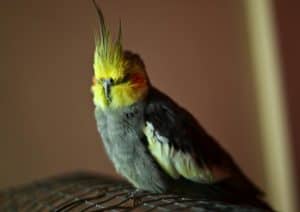If you’re exploring the world of domestic parrots and considering a cockatiel for your home, navigating the abundance of care advice can be daunting. Fortunately, caring for a cockatiel is straightforward with reliable guidelines based on scientific research and expert sources.
This comprehensive guide covers essential aspects such as diet, housing, toys, enrichment, and health care, ensuring your cockatiel thrives as a cherished companion.
| Name(s) (common, scientific) | Cockatiel, weiro bird, quarrion, Nymphicus hollandicus |
| Natural habitat | Arid Australian bushlands |
| Adult size | Up to 35 cm (14″) and up to 120 grams (4.2 oz.) |
| Lifespan | 25+ years |
| Noise level | Low (for a parrot) |
Cockatiel origin & natural habitat

If you want to care for an animal in captivity, it can be useful to examine its natural environment and routines. Cockatiels are no exception and have a few interesting quirks that you should know about.
Cockatiels (Nymphicus hollandicus) are native to Australia. They don’t live in one specific location there. They’re actually quite mobile and follow food and water sources across the country, moving in huge flocks that may include hundreds of individuals.
Although they’re nomadic, cockatiels do have a few requirements that must be met in order to thrive. They need access to water (which they often drink and bathe in), grasses and other plants to eat, and branches or other perching surfaces.
In the wild, cockatiels are always on the move. Their diet consists mainly of grass seeds, tubers, and roots, with some bugs or lizards thrown in for good measure.
Did you know? Cockatiels are an entirely distinct species from other parrot species, making them different from the genus Nymphicus. Cockatoos are, nevertheless, distantly related to them.
The natural habitat of the species is usually savannah, shrubland, and grassland. Dense forests aren’t preferred, but it’s essential that there are some trees, since cockatiels breed in hollow trees.
These habitats are not particularly pleasant. They may be semi-arid to extremely arid, and there are predators such as eagles. In this case, the cockatiel’s lifespan in the wild is significantly shorter than that of its captive counterparts (up to 15 years vs up to 25 or more).
So, what does this mean for you as a cockatiel caregiver?
Well, it’s important to try to replicate your bird’s natural environment as closely as possible. This means providing a diet that is as close to their wild diet as possible, having plenty of perching surfaces and toys that encourage movement, and making sure your bird has access to water.
Caring for a cockatiel: What do cockatiels eat?
There’s a reason we’re bringing up diet so early in this post. A staggering number of household parrots are malnourished or overweight based on research (Schoemaker, Lumeij, Dorrestein & Beynen, 1999).
Cockatiels are not immune to this. Vitamin A or calcium insufficiency, fatty liver disease, and other issues can all cause your beloved ‘tiel’s life to be shortened as a result of diet-related problems such as vitamin A or calcium deficiency, fatty liver disease, and more.
Of course, there are many benefits of providing your pet cockatiel with the healthiest diet possible. For one thing, it reduces costs in the long run, eliminating costly vet visits.
A healthy diet also means your bird will be more active and may even decide to explore or learn tricks! All in all, providing a diverse and nutritious diet may be the biggest gift you give your feathered companion.
Let’s go through a brief rundown of the wild cockatiel diet before moving on to what your household one should eat!
Wild cockatiel diet

The ability to shell a tiny seed with just the beak and then digest it effectively with the help of their long and muscular gizzard (the part of the intestinal tract that’s designed for grinding) is characteristic of wild cockatiels.
The seeds, insects, nuts, and berries they consume are determined by the region where these wild cockatiels live. Jones (1987) found that cockatiels preferred to congregate around areas with acacia trees, while other sources noted a preference for sorghum. Grass seeds are an important part of the diet year-round, but during the breeding season (which in Australia runs from July to January), cockatiels switch to a diet that’s high in insect protein.
Cockatiels, like other parrots, will eat anything they want. They consume a broad and intense diet that includes everything from acorns to apples. Seeds contain a lot of fat, making them ideal for these voracious birds. Since they consume both fresh and dry seeds from several plant species as well as any other edible goodies they can find, cockatiels are omnivorous.
Did you know? Cockatiels are omnivores and like to eat a variety of things. That’s why, when your cockatiel is cleaning its cage or scouring the ground for lost fragments, it’s usually looking for food. Keep an eye on your bird!
Captive cockatiel diet
In captivity, the sad reality is that we can’t give our cockatiels the same variety of fresh and dry seeds, as well as other meals, that they would find in the wild. The good news is that we don’t have to. A seed-based diet is quite rich in calories, which is great for wild birds that travel numerous miles each day in search of food. However, for pet birds that are inactive or confined to a small area, a diet high in calories and low in other nutrients can lead to health problems.
Commercial cockatiel diets were created to address this issue by providing a more balanced mix of nutrients. Pellets are an important part of a captive cockatiel’s diet and should make up about 60% of their daily food intake. The other major component of a captive cockatiel’s diet is fresh vegetables and fruit, which should make up about 20% of their diet. The remaining 20% can be made up of a variety of things, including cooked meat, grains, nuts, and legumes.
Cockatiels, like other birds, require a wide range of foods to thrive and are often at risk of eating their cage mates if they aren’t offered enough options. While conventional seed mixes (often comprised of canary seed, millet, sunflower seeds, and hemp) have long been the go-to diet for cockatiels, research has shown that they are nutritionally incomplete and can lead to health-related problems.
To provide your bird with a healthier diet, it’s important to supplement their seed diet with a variety of fresh vegetables, fruit, cooked meat, grains, and nuts. Doing so will help ensure that your cockatiel receives the nutrients they need to stay healthy and active.
While it’s not necessary to entirely eliminate seeds, using a high-quality pellet food as a regular meal for your cockatiel instead of a seed combination is highly advised. These pellets aren’t as calorie-dense as seeds and offer more (micro)nutrients but lack some calories.
Fresh vegetables, fresh fruits, some cooked (unsalted) grains and pasta, sprouts, and even foraged items like garden flowers, herbs, and fresh twigs can all be added to your bird’s diet.
Don’t forget to offer your cockatiel various sources of fresh, clean water in addition to everything else. You may also give a calcium block or cuttlebone.
One important part of a healthy cockatiel diet is to provide them with a variety of fresh vegetables and fruit.
Cockatiel temperament
Cockatiels can live in flocks of hundreds of individuals in the wild, giving them a significant safety in numbers advantage. They rely on their flock for protection, reproduction, preening, and other activities. They don’t have to waste energy looking for a new partner each year to reproduce since they bond with a single spouse. Cockatiels are social birds, not loners.
Of course, your pet cockatiel will enjoy the company of their human flock as well. Cockatiels are social creatures and prefer not to live alone. They are affectionate birds that enjoy being petted by their humans on a regular basis. Their temperament is calm but curious, often exploring their surroundings and taking an interest in everything going on around them.
Cockatiels are friendly, sociable birds that enjoy being near or around their owner, who they will regard as a member of the flock or even their spouse. After all, in a house setting, you’re part of the flock! You must keep their social nature in mind.
Did you know? In the wild, cockatiels will preen one another to cement their friendship and assist with itchy molt. A tamed cockatiel will ask you to do the same by bowing its head, so you can scratch its neck!
The Quaker parrot is one of the more laid-back species of parrots, which means they aren’t particularly loud, energetic, or nippy. This also implies that they don’t enjoy being handled: some parrots will even let you pick them up during playtime or hold them in your hands on their backs. Cockatiels are not one of those birds.
Cockatiels will enjoy your company and being petted on a regular basis, but they don’t like to be held on their backs as some other parrot species do. They are more likely to let you hold them on their side or even sit on your shoulder. This doesn’t mean they don’t want to be close to you.
Cockatiels, like other parrot kinds, are bright and engaging. They adore investigating and learning new things. To learn how to stimulate their active brains, scroll down to the section on enrichment!
Tip: Cockatiels that have been neglected or abused will not always seem to meet the above criteria. They can be irritable and uninterested in socializing. Don’t give up hope yet! You still have the ability to teach your bird to relax and enjoy life.
The crest
There are a few indications of parrot mood, such as the condition of their feathers, which are puffed out when the bird is calm and flat against its body. Another one is the beak. An open beak is used to menace others and is a good predictor of a bite, whereas a puffy parrot grinding its beak indicates contentment. A partially open beak or closed with a gentle curve is likely to be in between.
Eyes can also give away your parrot’s mood; they will either be squinting gently, which indicates contentment, or wide open when the heart races (beware of that bite).
Cockatiels have an additional indicator that can tell you a lot about how they’re feeling: their crest. Check out their head feathers and figure out what the various postures imply!
- 90° angle, completely vertical: scared or very vigilant.
- Erect but not entirely vertical: curious, watching what’s going on.
- Neutral positioning (about a 40° angle): relaxed, content.
- Flat against the head: aggressive, fearful.
Tip: Don’t forget to pay attention to your tiel’s vocalizations as well. They provide a wealth of information regarding how your bird is feeling! High-pitched screams are an indication that something is wrong, for example. If your tiel is whistling or singing, it’s likely feeling calm and flirty.
Males vs females
Female cockatiels, on the other hand, are regarded to be a little more reserved and less sociable than their male counterparts.
Males are more aggressive. They have a larger vocabulary and speak up more frequently. They’ll also be more interested in getting your attention! You may witness your male strutting, making a heart shape with his wings, clapping on things, and skipping around. If your tiel is making groaning noises when you pet it, this probably means the bird wants more pets, or it’s trying to get back at you for spending too much time away from home.
Caring for a cockatiel: housing
The right housing is an essential component of caring for your cockatiel so it can be happy and healthy. Your bird will consider its cage to be its home: a secure place to unwind before settling down for sleep.
The specific size needs for a cockatiel cage are determined by how much time your bird spends in the cage. If your bird has free access to the rest of the house all day, it’s certainly not the same as if you offer it only a few hours of out-of-cage time each day.
A cage for a cockatiel should be roomy enough to hold several parrot perches (at least 2-3, ideally near the top of the cage). The food bowls as well as plenty of playthings should also be able to fit within the confines yet still allow for the bird to spread its wings and hop or fly about.
Anything smaller than 24 inches (61 cm) in length, as a rule of thumb, should be avoided. For a cage that is primarily used to sleep in, this guideline is appropriate. Although vertical parrot cages are more popular, a rectangular one is ideal in terms of floor space. Cockatiels and other parrots prefer horizontal over vertical room in the wild.
In general, you should avoid keeping your cockatiel in a cage for more than ten hours a day. If it spends any time out of its cage overnight, let alone during the day, get a bigger one! In either case, plenty of environmental enrichment is essential to make your feathered pet’s life fulfilling and stimulating.
Did you know? Cockatiels are prone to night terrors, in which they become terrified and can severely damage themselves. A night light close to the cage may be required.
Caring for a cockatiel: enrichment
There are several things you may do to ensure that your cockatiel is both healthy and happy. There’s no need for your bird to be bored!
Provide several hours outside the cage each day to keep your ‘tiel active and encourage it to explore. Also, remember the enrichment options listed below.
The social aspect
The most essential aspect to consider before adding a cockatiel to your family is how much time you’ll be spending with your bird. They can spontaneously generate enormous flocks, and they need other cockatiels for protection and companionship. They also form lifelong relationships.
It is essential to have more than one cockatiel if it isn’t an option for you to provide enrichment in the form of spending lots of time with your bird on a daily basis (hanging out, training, whistling, and more). If you don’t provide social connections, their social brains will shrivel.
When its social requirements are not satisfied, a cockatiel, like other parrots, will act out. A deprived ‘tiel might pluck its feathers, scream continuously, or even become violent as a result of psychological deprivation.
Training
So, what are you supposed to do during the hours when you should be spending with your cockatiel? Simply hanging out is fine, but think about investing some time in training as well.
Other than instilling tricks in your cockatiel, training it offers more advantages than just that. Some examples include:
- Cockatiel enrichment and brain training can be provided in many ways. It prevents your bird from becoming bored.
- It also helps you develop a closer relationship with your bird.
- It enables you to recognize and reward desirable actions while discouraging undesirable ones.
It’s also worth noting that being able to step up and down is very beneficial for cockatiels. Or entertaining things like tricks! You may also teach your ‘tiel some songs or easy phrases with simple speaking training.
Toys
Cockatiels adore playing, just like other parrots. They enjoy mouthing, picking, lunging, shredding, perplexing, and more! As a result of this fact, caring for a cockatiel necessitates providing your bird with lots of toys.
‘Toys’ is a broad term. There are numerous (and I mean A LOT) brands and types of parrot toys available, including some that are appropriate for cockatiels. They’re often brightly colored with vegetable dye to make them more appealing and include moving pieces, dangling parts, bells, and other entertaining elements.
Another way to entertain your bird is to build a parrot toy. If you want to do it yourself, there are several options available. You may buy ready-made parrot toy kits that allow you to make numerous toys at once. Alternatively, you might go all out and use things like shredded paper and other home supplies in order to make your ‘tiel’s favorite toy!
Tip: Make or buy many toys and exchange them every two weeks or so to keep things fresh and new.
It’s vital to remember that, while not all parrot toys available in your local pet shop are hazardous, many of them aren’t. The following are some examples of unsafe toys:
- The fleece snuggle huts are made of fleece, and birds enjoy chewing on them, resulting in crop impaction.
- If it’s not totally intact, the regular rope is dangerous. A foot might become trapped in frayed rope.
- Avoid nets, cords, and any other instrument that a beak or foot might get caught in.
- It might be difficult for your bird to walk around with a looped ring (unless it’s too big for its head to get trapped in).
- Paint, varnish, glue, or expose yourself to any substance that may cause harm.
Tip: Aside from toys, offer your cockatiel a bath. They enjoy running about to shake off the dirt and dander.
Foraging
One of the best ways to provide enrichment and trigger natural behaviors that aren’t frequently seen is to encourage foraging (Coulton, Waran, & Young, 1997). Consider this: your cockatiel would spend most of its day scouring the ground for tasty items in the wild. You put food in a bowl, and it’s gone in minutes. Sound familiar?
In the wild, a cockatiel would have to work for its food. It would have to search through nooks and crannies, overturn leaves and branches, and do whatever it could to find something to eat. This is what we try to simulate with foraging.
Make it more difficult than that. Your bird will enjoy earning its snacks! That’s what its intelligent mind was designed to do.
You don’t need to perform anything fancy, and even sprinkling pellets on the bottom of the cage keeps your tiel engaged for longer than simply tossing them into its dinner bowl.
Also consider:
- Offering larger items such as fruits, vegetables, and other whole foods that your cockatiel will need to break down.
- Make simple foraging toys that need a little effort to use.
- Foraging for non-contaminated, bird-safe branches such as Eucalyptus, which is native to the cockatiel’s territory.
- A foraging box has food hidden between shredded paper and other items.
Cockatiel sounds
Are cockatiels loud?
After you’ve decided whether or not to bring any type of parrot into your life, consider how well you manage noise. If you want peace and quiet, these birds are not for you. Cockatiels are one of the more quiet species, but if you have one, don’t expect to be able to enjoy complete silence all the time!
Male cockatiels are the most talkative cockatiels, and they may whistle to you, their toys, or their partner. This does not imply that a female will be completely silent, however. They still produce the standard high ‘eep eep’ flock sound.
When a cockatiel is dissatisfied about anything, it’s common for it to scream. You may not always be able to determine what it’s about. It’s just noise for the sake of noise at times.
Consider watching a video on cockatiel sounds and considering whether you can handle listening to these noises for most of the day.
Cockatiel talking
Let’s get to the good part. Apart from all of those typical cockatiel eeps, chirps, warbles, and other noises, these birds may also mimic human speech.
Now, keep in mind that cockatiels are not great talkers. They can learn some songs and short phrases, after all, and talking training is a lot of fun to do together. Make sure you’re prepared to exercise your patience muscle because it’s quite possible that you’ll have to repeat a phrase hundreds of times before your tiel understands it.
Males are generally the greatest candidates for language training since they are more vocal in order to attract a mate.
Cockatiel colors
The most popular cockatiel color is the wild form. Males will be light grey with a yellow head (as shown below), while females have a grey head.
Cockatiels come in a variety of colors and patterns thanks to selective breeding, which has allowed for the development of a large number of distinct cockatiel hues and patterns. The following are some examples:
- Lutino: A yellow cockatiel with orange cheek patches and red eyes owing to a lack of the melanin that gives grey coloration.
- Pied: Features a unique, uneven coloration.
- Pearl: The spotted pattern will eventually go away in males, although it depends on the species. It’s possible that females won’t lose it.
- Whiteface: There are no yellow or orange hues in this breed; rather, it is completely grey (with a white face on the males).
- Albino: Yes, it’s a lutino. A totally white bird is created when yellow is absent!
Did you know? In wild type cockatiels, the distinction between males and females is visible at a glance, as the ladies have a grey head. It’s somewhat more difficult in other color variations (for example, pieds). To be sure of the precise color aberration, you must know it. Fortunately, DNA testing is available!
Caring for a cockatiel: Medical emergencies
Before we finish this guide to cockatiel care, let’s take a look at one more essential but unpleasant aspect of cockatiel care.
It’s critical to have a strategy in place for medical issues, just as it is with any animal. It’s also crucial to be able to identify common symptoms of the disease.
Tip: Is it time to add a new cockatiel to your flock? For a basic check-up, you should always make an appointment with the veterinarian. It’s better safe than sorry! An annual examination is also unnecessary.
Symptoms
A cockatiel’s bad day is nothing to be concerned about. This is especially true when the bird is molting, when it may seem irritable and “off” for a time. The occurrence of an occasional sneeze isn’t significant, considering that they’re quite dusty creatures!
What you should definitely keep an eye out for is the following:
- Excessive resting or lack of reactivity, with puffed feathers. It’s possible that it’s on the cage’s bottom.
- There is a lack of interest in food.
- Persistent sneezing is accompanied by a gray or yellow discharge, especially if it isn’t clear.
- Bleeding. It’s critical to get prompt medical aid if a bird suddenly bleeds out.
- Wheezing.
- Poops with an unusual appearance. You should be able to recognize a healthy poop!
- Tail bobbing.
- Vomiting is another one of the most popular signs to watch for. Cockatiels can vomit, too!
Aside from that, simply keep an eye on your pet. You are familiar with its typical behavioral patterns and how it looks. If something changes suddenly, a trip to the veterinarian is suggested.
Emergency planning
If something is wrong with your cockatiel, you must be prepared to spring into action right away.
Make sure you’ve got the following in order:
- Have the contact information for at least one or two avian veterinarians in your region on hand.
- Veterinary treatments are not cheap. An emergency fund might assist with this. I prefer having around €350 set aside, which is $400-$450 in cash.
- Have a roadside bird rescue kit stowed away in your car. Blood clotting powder, tweezers, bandages, and disinfectant wipes are just a few of the items that should be included.
- A travel cage or an extra shoebox might be really useful.







